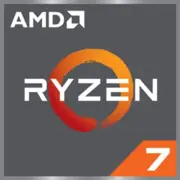AMD Ryzen 7 PRO 2700X

AMD Ryzen 7 PRO 2700X: Review and Practical Guide for 2025
Relevance in 2025: Is this processor worth considering today?
Despite being released in 2018, the AMD Ryzen 7 PRO 2700X remains a popular choice for budget workstations and upgrading old systems. In 2025, when processors based on the Zen 4 architecture and the Intel Core 14th generation dominate, this chip stands out with its affordability (around $150–180 for a new model) and proven reliability. Let's explore who it is suitable for and what its strengths are.
1. Key Specifications: Zen Architecture and Performance Balance
Architecture and Manufacturing Process
The Ryzen 7 PRO 2700X is built on the Zen+ microarchitecture (codename "Pinnacle Ridge") with a 12 nm manufacturing process. This is the second generation of Ryzen, which improved clock potential and energy efficiency compared to the original Zen (14 nm).
- 8 cores / 16 threads — a foundation for multi-threaded tasks.
- Base clock: 3.6 GHz, maximum boost clock: 4.3 GHz.
- Cache: L3 — 16 MB, L2 — 4 MB.
- TDP: 95 W — moderate power consumption for its class.
Performance:
- Geekbench 6: 1279 (single-thread) / 6213 (multi-thread).
For comparison: the Ryzen 5 5600X (Zen 3) scores about ~1600/6000 but lags in multi-threading.
Key Features of the PRO Version:
- AMD GuardMI Technology — hardware data encryption.
- Remote Management (DASH, Manageability Engine) — useful for corporate systems.
- Extended Warranty — up to 3 years.
2. Compatible Motherboards: AM4 Socket and Chipset Selection
The processor uses the AM4 socket, supported by motherboards with chipsets:
- B450 — the optimal choice for most users. Example: MSI B450 Tomahawk Max ($80–100).
- X470/X570 — for enthusiasts (PCIe 4.0 support on X570). Note: the Ryzen 7 PRO 2700X only operates with PCIe 3.0.
Features:
- For B450/X470 boards, a BIOS update may be required (use Flashback if you don't have an old CPU on hand).
- X570 is redundant for this processor but will suit future upgrades to Ryzen 5000.
3. Supported Memory: DDR4 and Optimization
The Ryzen 7 PRO 2700X works with DDR4 (does not support DDR5!).
- Officially: up to 2933 MHz (without overclocking).
- In practice: reliably works with modules at 3200–3400 MHz (depending on chip quality and motherboard).
Recommendations:
- Use a dual-channel configuration (2×8 GB or 2×16 GB).
- Optimal timings: CL16–CL18. Example: Kingston Fury Renegade DDR4-3200 ($60 for 16 GB).
4. Power Supply: Power Calculation and Stability
With a TDP of 95 W and average power consumption under load of ~140–160 W (considering the GPU):
- Minimum: 500 W (for systems with a GPU like the NVIDIA RTX 3060).
- Recommended: 650 W (buffer for upgrades and stability).
Selection Criteria:
- 80+ Bronze certification or higher (e.g., Corsair CX650M — $75).
- Quality capacitors and overload protection.
5. Pros and Cons: Why You Should (or Shouldn't) Consider in 2025
Pros:
- Price: twice as cheap as the Ryzen 7 5700X ($300) while maintaining similar multi-threading performance.
- Reliability: proven AM4 platform.
- Multitasking: 16 threads are relevant for rendering, streaming, and virtualization.
Cons:
- Weak single-thread performance: lags behind the Ryzen 5 5600 in games by 15–20%.
- No PCIe 4.0 — a limitation for SSDs and new GPUs (e.g., the RTX 4070 loses 5–7% performance on PCIe 3.0).
- Energy efficiency: new processors (like the Ryzen 5 7500F) consume 30% less power at similar performance levels.
6. Use Cases: Where the Potential Unfolds
- Work Tasks:
- Video editing in DaVinci Resolve, 3D rendering in Blender.
- Server applications (virtual machines, databases).
- Gaming:
- Comfortable operation in Full HD with GPUs like the RTX 3060. In AAA projects (Cyberpunk 2077) — 60–80 FPS at high settings.
- Drops in CPU-intensive games (Microsoft Flight Simulator 2024) due to weak IPC.
- Multimedia: Streaming in OBS without lags thanks to 16 threads.
7. Comparison with Competitors: Ryzen 7 PRO 2700X vs Intel i7-9700K vs Ryzen 5 5600
- Intel Core i7-9700K (8C/8T):
- Better in games (+10% single-thread score) but worse in multi-threaded tasks (–25%). Price: $200–220.
- Ryzen 5 5600 (6C/12T):
- Newer (Zen 3), higher IPC, PCIe 4.0 support. Single-thread performance +25%, multi-threaded –15%. Price: $180–200.
Conclusion: The 2700X excels in rendering but falls short in gaming and energy efficiency.
8. Assembly Tips: How to Avoid Mistakes
- Cooling: The boxed Wraith Prism cooler works, but for overclocking it is better to get a DeepCool AK400 ($35).
- Motherboard: Choose models with VRM heat sinks (e.g., Asus ROG Strix B450-F).
- BIOS: Update to the latest version for improved memory stability.
- SSD: Use NVMe drives (e.g., Kingston NV2 1 TB — $60), but don't expect PCIe 4.0 speeds.
9. Final Verdict: Who Is the Ryzen 7 PRO 2700X Suitable for in 2025?
This processor is worth considering if:
- You are on a budget, and need multi-threaded performance.
- Upgrading an old AM4 system without changing the motherboard.
- Corporate tasks: office PCs with security requirements (GuardMI).
However, for new builds focused on gaming or energy efficiency, it is better to look at the Ryzen 5 7500F or Intel Core i5-13400F.
Conclusion: The Ryzen 7 PRO 2700X in 2025 is a "workhorse" for specific tasks, but not for gamers seeking maximum FPS.
Basic
CPU Specifications
Memory Specifications
GPU Specifications
Miscellaneous
Benchmarks
Compared to Other CPU
Share in social media
Or Link To Us
<a href="https://cputronic.com/index.php/cpu/amd-ryzen-7-pro-2700x" target="_blank">AMD Ryzen 7 PRO 2700X</a>